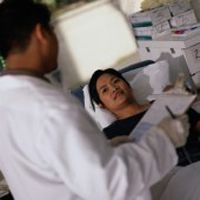Treatment with Direct-acting Antivirals Achieves Sustained Virologic Response in Patients with Hepatitis C
Study results presented at The Liver Meeting 2012 show that administering two direct-acting antivirals results in a high rate of sustained virologic response in patients with hepatitis C who failed previous treatment with ribavirin/peginterferon.

Treatment with two direct-acting antivirals (DAAs) without ribavirin or peginterferon-alpha can achieve a high rate of sustained virologic response in patients with hepatitis C virus (HCV) who had previously failed standard therapy with ribavirin/peginterferon, according to research presented at The Liver Meeting, the 63rd Annual Meeting of the American Association for the Study of Liver Diseases (AASLD).
In patients with HCV genotype 1b, 78% of patients achieved a sustained virologic response at 12 weeks post-therapy (SVR12) when daclatasvir was dosed once daily and asunaprevir was dosed twice daily. Patients who received only once-daily asunaprevir achieved SVR12 at a rate of 65%.
Daclatasvir is a viral replication complex inhibitor, and asunaprevir is a viral protease inhibitor. The drugs are in development from Bristol-Myers Squibb, which sponsored the trial. Viral genotype 1b (Gt1b) is more common in Asian countries than in the United States, although the US does contain an important number of patients with this genotype.
“Oral combinations of direct acting antivirals are clearly desired in this field,” said lead investigator Mark Sulkowski, MD, of Johns Hopkins University in Baltimore, MD. The development of oral DAAs is potentially a major step forward in the field, if they can reduce or replace the need for peginterferon, which must in injected weekly, and ribavirin, which increases the risk off anemia. In addition, a significant fraction of HCV patients either never respond or respond only partially to standard therapy.
In the trial, Gt1b patients received one of four dosing regimens for 24 weeks: daclatasvir plus asunaprevir twice daily (Group A1); daclatasvir plus asunaprevir once daily (Group A2), or each of those regimens with ribavirin plus peginterferon. Patients were 54% male, with a mean age of 55, and all had previously failed to respond to standard ribavirin/peginterferon therapy.
Of the 18 patients in Group A1, 14 (78%) achieved SVR12, while of the 20 patients in Group A2, 13 (65%) achieved SVR12.
There were no differences in response to treatment based on ribavirin administration. Neither was there an effect from IL28B gene status, an important determinant of response to standard therapy. Viral subtype also was not associated with therapy response.
There have been no confirmed relapses out to week 12, Sulkowski reported. One patient had detectable viremia at week 24, consistent with a new virus and possibly linked to ongoing intravenous drug use.
Eight patients experienced virologic breakthrough, and received rescue therapy with ribavirin/peginterferon. Most patients experiencing breakthrough had viral polymorphisms that confer resistance to daclatasvir.
Fatigue, headache, and nausea were the most commonly reported adverse events. All were mild to moderate in intensity. Anemia was seen only in patients taking ribavirin.
Based on these results, the ongoing role for ribavirin “remains extremely interesting; up until recently it was critical, and we are still very early in understanding its role going forward,” said Sulkowski. “But it was encouraging that this combination may not require ribavirin.” He also said that it is possible that using ribavirin in combination with DAAs may allow further shortening of therapy, but this will require further study.
2 Commerce Drive
Cranbury, NJ 08512
All rights reserved.